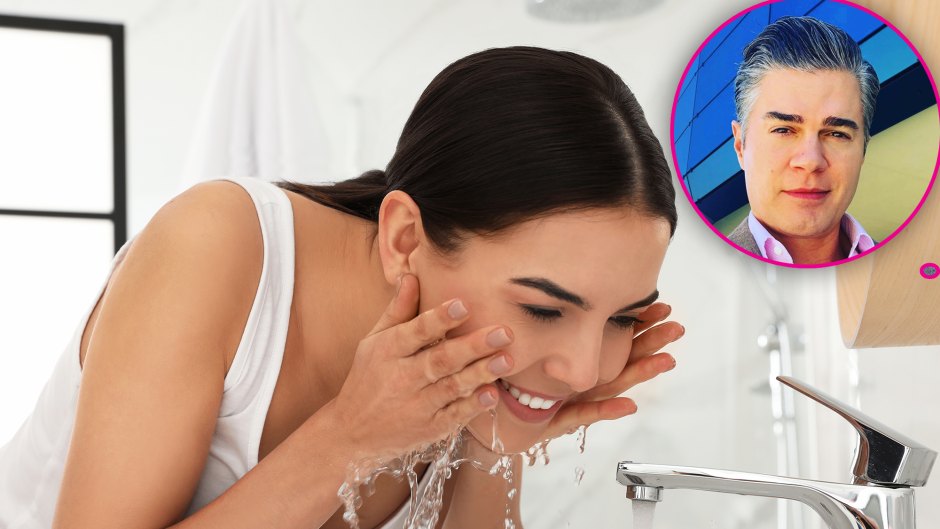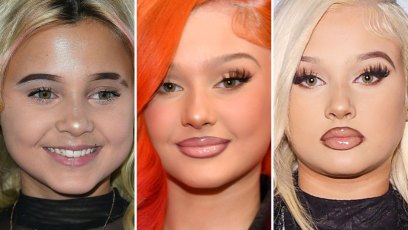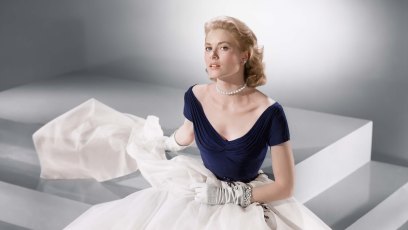
Shutterstock; Inset: Courtesy of Will Kirby/Instagram
Skin Check-In With Dr. Will: Wash the Day Away With These Experts Tips on Nighttime Skincare
Welcome to your skin check-in with Life & Style’s resident health and beauty expert, Dr. Will Kirby, a celebrity dermatologist and Chief Medical Officer of LaserAway. Every week, he’ll be spilling his candid thoughts and professional advice on all things skin, beauty and wellness as it relates to you — and your favorite stars.
Now that I’ve covered how to organize your morning skincare routine, it’s time to talk about what to do before bed. After a long day, you’ll need to remove your makeup! I’m comfortable with you removing makeup by any option that makes the most sense to you. That can be via a foaming wash, wipes, a mechanical brush or cleansing water. Again, it really doesn’t matter how you remove makeup, as long as it’s done thoroughly, but gently.
After removing makeup, most people like to wash their face to remove any residue. I’m not a fan of expensive washes — they aren’t on your face for long, so even if they contain great ingredients, they offer no meaningful benefit. Pick a gentle wash of your choosing and as a rule, only wash with cool or lukewarm water. Hot water can cause irritation, redness and excess sebum production.
Many patients use a toner and when I ask them why, they don’t have an answer. This is because toners are misunderstood and not everyone needs one! A toner is a liquid that is applied and removed with a cotton swab and this process can help remove any last traces of oil or makeup that remain.
In theory, toners also might help balance the pH of the skin, as well as help gently exfoliate. Ultimately, toners seem to be most useful to people who suffer from acne. So, if you like using a toner, please do so, but if you don’t have acne and don’t think you need a toner, skip it.
The thinnest skin on the female body is around the eyes and I recommend that eye creams be applied at night. Use the pad of your fourth finger/ring finger to gently dap a small amount of eye cream to that delicate skin and never rub that area!
OK, now it’s time for a moisturizer … or is it? Not everyone needs a moisturizer! If you have oily skin and live in a humid climate then using a moisturizer might actually be a waste of time and money. It could also lead to blackheads! It is also possible that some parts of your face are dry, while other parts are oily, so you may elect to only apply moisturizer to select areas of tour face.
The main point is that you don’t necessarily need a moisturizer all over and some of you might not need a moisturizer at all. Next, at night, and only at night, I strongly, strongly recommend a retinol or a retinoid. There is a lot of confusion about these products, and the best way to think of them is that they are very closely related. The most important thing is that you wear one or the other every single night.
To get slightly more granular, retinoids are available by prescription only and they convert to retinols once they are applied to your skin. Retinols simply bypass that conversion step and are available over-the-counter without a prescription. Studies show that both retinols and retinoids are effective and some medical literature indicates over time, there is no clinical difference between the two.
So what do retinoids/retinols do? They increase surface cell turnover. That results in smoother, softer, more supple skin. Now, I can’t emphasize this next part enough: A pearl-sized amount of a retinoid/retinol is enough to cover tour whole face. Using more won’t speed up the process!
In fact, using more will only cause irritation. It takes approximately eight weeks to see results from retinoids/retinols and during that time it is normal to experience irritation. Mix your retinol/retinoid with a tiny bit of your favorite moisturizer to help it spread more easily and to mitigate some potential irritation while you are getting used to it.































![Zendaya Goes Braless in Deep Plunging Neon Dress for Challengers Event [Photos]](https://www.lifeandstylemag.com/wp-content/uploads/2024/04/Zendaya-Goes-Braless-in-Deep-Plunging-Neon-Dress-for-Challengers-Event-06.jpeg?crop=0px%2C332px%2C2520px%2C2520px&resize=300%2C300&quality=86&strip=all)
![Zendaya Goes Braless in Deep Plunging Neon Dress for Challengers Event [Photos]](https://www.lifeandstylemag.com/wp-content/uploads/2024/04/Zendaya-Goes-Braless-in-Deep-Plunging-Neon-Dress-for-Challengers-Event-06.jpeg?crop=0px%2C346px%2C2520px%2C1428px&resize=408%2C230&quality=86&strip=all)







